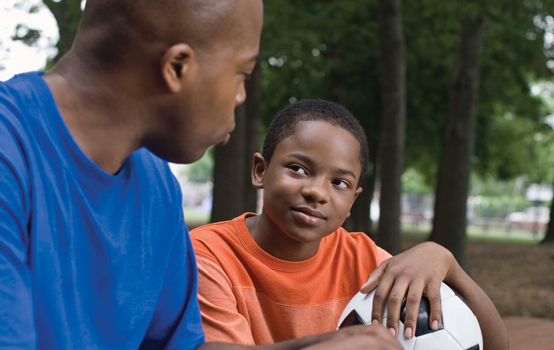Students in an after-school mentoring program describe the qualities that made their mentors so effective.
“Whoops, excuse me, ma’am, sorry,” a middle school student exclaimed to me as he ran directly into my path as I opened the cafeteria door to enter a room that was abuzz with boisterous conversation, laughter, and activity. This was the setting of an after-school mentoring program for adolescent boys of color that focused on personal and cultural affirmation, academic and career planning, and community engagement. As a researcher conducting a pilot project on factors associated with success among urban middle school students, I took a moment to take it all in, savoring the privilege of having the opportunity to meld academic research with actual work being done with youth in schools. I was quickly welcomed by Enzo (a pseudonym), the program coordinator, a Latino in his 20s or 30s who served as the boys’ primary instructional mentor: “Hey, welcome — glad to meet you. I hope you don’t mind the noise — our boys are full of pent-up energy at this time of the day.”
During the session that afternoon, I watched a small group of boys working noisily together on some sort of paper chain for an upcoming field day, a two-on-two basketball game, adult mentors — all men of color— providing individualized homework support, and pairs of students with their heads huddled close as they focused on iPad screens. But one thing that particularly stuck with me was how Enzo referred to the students in the program: our boys.
Over the coming weeks, I kept thinking about Enzo’s words, as I observed the mentors’ constant awareness of what was going on in the space, the judicious way they helped students manage their conflicts, their skills at facilitating group discussion, and their patience in listening to endless stories. For the mentors, these weren’t just kids who happened to be in the program, they were kids for whom the mentor instructors held collective responsibility. Kids the mentors cared about and took the time to really know. Kids whose success was both expected and supported. I found myself wondering what effect this kind of mentoring has on students, especially during this formative period. The students themselves would provide me with real and honest answers to this important question.
The value of mentoring in early adolescence
We in education and academic circles know that early adolescence is a time of both enormous potential and great vulnerability, as tweens and young teens experience rapid change across developmental domains (Gutman & Eccles, 2007). Adolescents whose homes, schools, and communities do not make room for their changing needs are more likely to experience difficulties, while those in more supportive contexts experience more positive outcomes.
Unfortunately, school-based support during the early adolescent period is often inadequate, providing a poor fit for students’ developmental needs (Roeser & Eccles, 1998). Specifically, students tend to experience a great deal of dissonance between elementary and middle school, exacerbating the challenges of this critical transition. In elementary school, students generally receive most of their instruction in a single classroom with a consistent group of peers and teachers, which allows for more individualized instruction, continuity, and deeper teacher-student relationships. In contrast, middle schools are often larger, and students receive their instruction from many different teachers, which requires them to manage the complexities of changing classrooms (with different teachers and peers in each class) with relative independence. Hence, during a time of rapid identity development, heightened self-consciousness, and the quest to find one’s place among the social group, middle school students often receive less, rather than more, support from teachers and other significant adults.
Mentoring programs can hold particular significance for young males of color, who often face additional school-based challenges.
For these reasons, mentoring has enormous potential to play a pivotal role in providing students with the individualized, relational, and broad-based support they need during the early adolescent years. In fact, research suggests that positive mentoring programs are beneficial across academic, social, and emotional domains, especially for youth marginalized by race, ethnicity, socio-economic, language, or other sociocultural categories (Gutman & Schoon, 2015). Specifically, mentoring programs can hold particular significance for young males of color, who often face additional school-based challenges associated with disproportionately low academic achievement and expectations, lower rates of enrollment in honors and college-preparatory courses, and more frequent and punitive discipline policies (Fergus, Noguera, & Martin, 2014).
Yet what kind of support is most ideal for these students? The literature is replete with information on best practices for the delivery of effective mentoring strategies for youth, such as staying attuned and responsive to their individual interests and needs, finding opportunities to collaborate with them, and making a commitment to sustained companionship (see Pryce, 2012; Spencer, 2006). However, as robust as the research literature is, less is known about how youth themselves — especially youth of color — actually evaluate their mentoring experiences (see Varga & Deutsch, 2016, for one recent example). Examining students’ own insights on the attributes of effective mentoring can contribute both to the development of high-quality mentoring programs and to the nurturing of attributes necessary for mentors to provide culturally affirming and developmentally appropriate support. Put another way, considering students’ own views can aid in the process of finding a good fit between what young adolescent boys of color say they need and the kinds of mentoring support that they receive.
What students want from mentors
To understand students’ views on mentoring, I conducted individual interviews and focus groups with seven male students of color who were enrolled in the aforementioned mentoring program. From these conversations, four themes emerged that illustrate students’ perceptions of effective mentorship. The students were 12-15 years old and were racially, ethnically, and linguistically diverse. During my interviews, which addressed their overall school experiences, I sought to understand their views on mentoring by asking these questions: What kinds of things does a good mentor do? How would you describe your ideal mentor? What is most important about your mentors in this program?
He gets us.
The most consistent attribute that students mentioned was being an understanding person they could relate to. Although they spoke in mostly positive terms about their classroom teachers, they described their mentors as providing something different. Specifically, they saw teachers (who were overwhelmingly female) as part of an obligatory, procedural relationship. This wasn’t necessarily a bad thing, as they expected to learn from their teachers, but they did not necessarily expect to be understood by them. In contrast, they saw their mentors as adults they could connect with on a more personal level, at least in part because they shared some of the same experiences. One student explained that his mentor “was in this school when he was younger, so he knows all of the things that happened here, and he can relate to a lot of our problems.” Indeed, mentors’ ability to personally empathize with the boys’ situations was seen as integral to their ability to provide help.
He’s always supportive.
It was important to the boys that they could talk openly with their mentors and that the mentors were trustworthy and generous in giving them guidance and advice and in helping them solve their problems. Mentors did not shut students down but were committed to listening and helping them find solutions. When students needed additional supports that the mentors could not provide, they could act as liaisons to others who could help. Several students described occasions when their mentors reached out to school staff or family members to advocate on their behalf. In the boys’ words, support that was unconditional, whereby they could talk about “not only school stuff,” was deemed critical, as was the willingness of mentors to “stick with us” no matter what was going on. As well, equitable support — as reflected in the comment, “if you’re only nice to kids that are a certain race . . . you’re not being a good mentor” — was important.
He believes in us.
During the interviews, the boys frequently described racially charged interactions with peers and teachers. These ranged from noticing biases or stereotypes about their own or other racial-ethnic groups that people seemed to hold (the most common situation) to hearing outright racist slurs or derogatory comments within their peer networks. As students navigated these tensions, having an adult mentor who could help them process what was going on was essential. In particular, they appreciated having their mentor affirm their best characteristics and clearly articulate their potential as young men, thus providing a counter-narrative to stereotypes often placed upon young boys of color. One student told me:
One [teacher] was calling us thugs, and [our mentor] was telling us “when people say that, they should know you aren’t thugs, you’re young men. You’re people who are coming and staying after school, doing something good . . . you’re learning something.” [Our mentors] call us young men, when people call us thugs.
It is important to note that this student likely would not have confided in his mentor about his negative experience with another teacher if he and his mentor had not already established a strong sense of rapport and understanding.
He inspires me to do my best.
Finally, good mentors facilitated what the boys saw as their own personal growth. One boy, for example, commented that his program mentors “made me into the person I am today, because like without them I couldn’t be myself. I want to say a mentor sort of like fuels who you are.” The boys were able to identify ways that they had changed over the school year, such as by understanding more about what they were good at, learning new study habits, or being more astute about making good choices. They credited their mentors as being integral to this process. Regardless of whether they would continue on in the program, the relationships students built with their mentors appeared to be ones they were extremely grateful for, and ones they would not soon forget.
Implications for schools
Adolescent males of color — especially Black and Latinx youth — are a vulnerable group within many schools, often undervalued and perceived as unteachable (Emdin, 2017). Themes such as authenticity, empathy, collaboration, and companionship are noted throughout the literature as integral to successful mentoring relationships (Rhodes et al., 2008). While the findings here are consistent with these themes, they also suggest that for early adolescent boys of color, special attention should be given to their desire for relational closeness and their need to be seen as young men with value and potential. The type of effective mentoring presented here can provide psychological safety and critical social-emotional support for such students during an important developmental period, and such support can influence their future trajectories. The mentors in this study also facilitated a sense of belonging within the entire group, reflected in one boy’s powerful comment that “it’s not like family, it is family here.”
We can learn a lot from adolescent youth as they deconstruct their own school experiences in their own words. Although any adult — regardless of race, gender, or cultural background — can embody the key ingredients of a successful mentor, my findings suggest that for adolescent boys of color, the benefits of having mentors who share their racial-ethnic background, and in whom they can see themselves reflected, are particularly salient. Nonetheless, this is work that we all must take up as educators who work with young people. As racial-ethnic diversity within the (majority White) teaching force continues to be a priority in U.S. schools, we need more educators of color like Enzo and his colleagues who view mentoring our boys as critical. Yet how much more powerful might our collective impact be if we, as diverse educators, join together in an earnest commitment to create institutional cultures of mentoring in schools where relational, affirming, and responsive support for youth of color is paramount? Framed within the imperative to provide a rich and nurturing education to all students, this is a truly exciting and much‑needed initiative.
References
Emdin, C. (2017). For white folks who teach in the hood, and the rest of y’all too: Reality pedagogy and urban education. Boston, MA: Beacon Press.
Fergus, E., Noguera, P., & Martin, M. (2014). Schooling for resilience: Improving the life trajectory of Black and Latino boys. Cambridge, MA: Harvard Education Press.
Gutman, L.M. & Eccles, J.S. (2007). Stage-environment fit during adolescence: Trajectories of family relations and adolescent outcomes. Developmental Psychology, 43 (2), 522-537.
Gutman L.M. & Schoon, I. (2015). Preventative interventions for children and adolescents: A review of meta-analytic evidence. European Psychologist, 20 (4), 231-241.
Pryce, J. (2012). Mentor attunement: An approach to successful school-based mentoring relationships. Child Adolescent Social Work, 29, 285-305.
Rhodes, J.E., Spencer, R., Keller, T.E., Liang, B., & Noam, G. (2008). A model for influencing of mentoring relationships on youth development. Journal of Community Psychology, 34 (6), 691-707.
Roeser, R.W. & Eccles, J.S. (1998). Adolescents’ perceptions of middle school: Relation to longitudinal changes in academic and psychological adjustment. Journal of Research on Adolescence, 88, 123-158.
Spencer, R. (2006). Understanding the mentoring process between adolescents and adults. Youth & Society, 37 (3), 287-315.
Varga, S.M. & Deutsch, N.L. (2016). Revealing both sides of the story: A comparative analysis of mentors and protégés’ relational perspectives. Journal of Primary Prevention, 37, 449-465.
Citation: Durand, T.M. (2019, Sept. 23) “It’s not like family, it is family”: Reflections on a mentoring program for boys of color. Phi Delta Kappan, 101 (2), 52-55.
ABOUT THE AUTHOR

Tina M. Durand
TINA M. DURAND is a clinical associate professor applied human development in the Wheelock College of Education and Human Development at Boston University.










